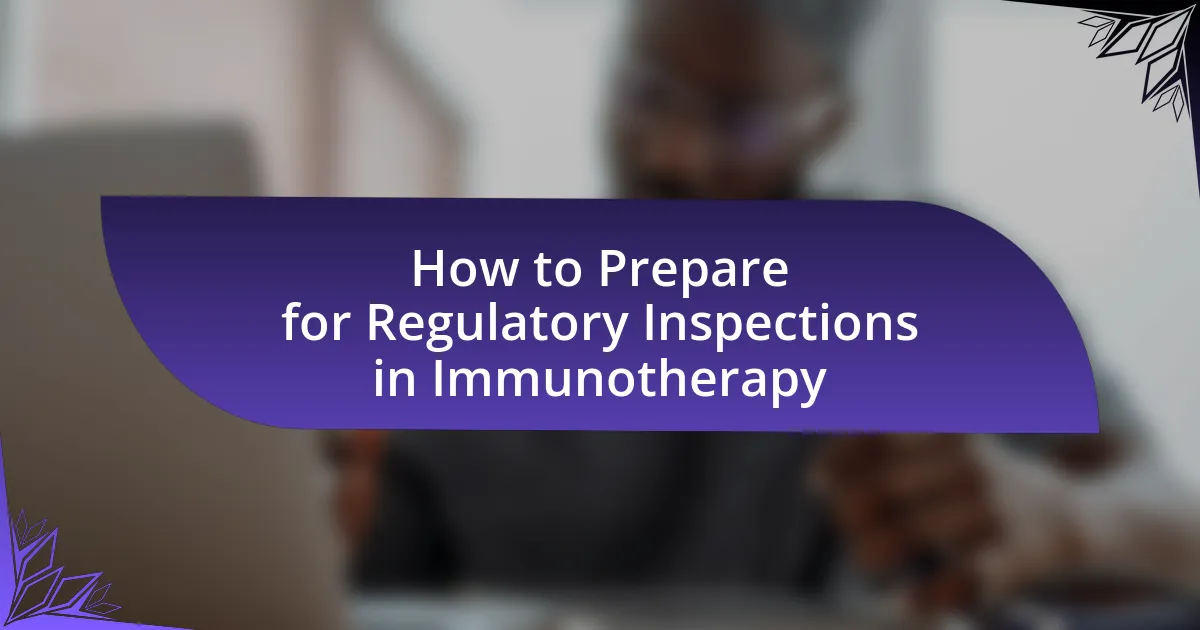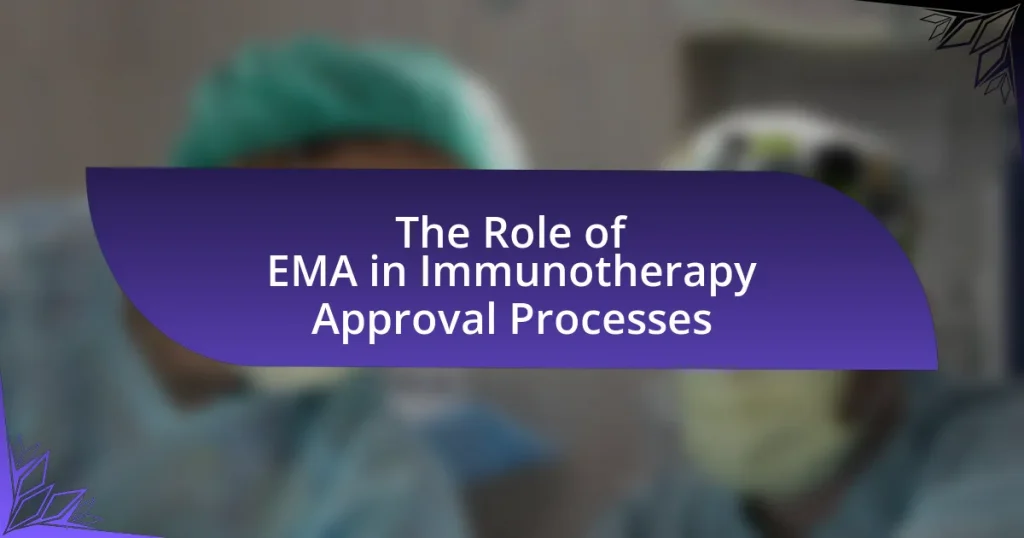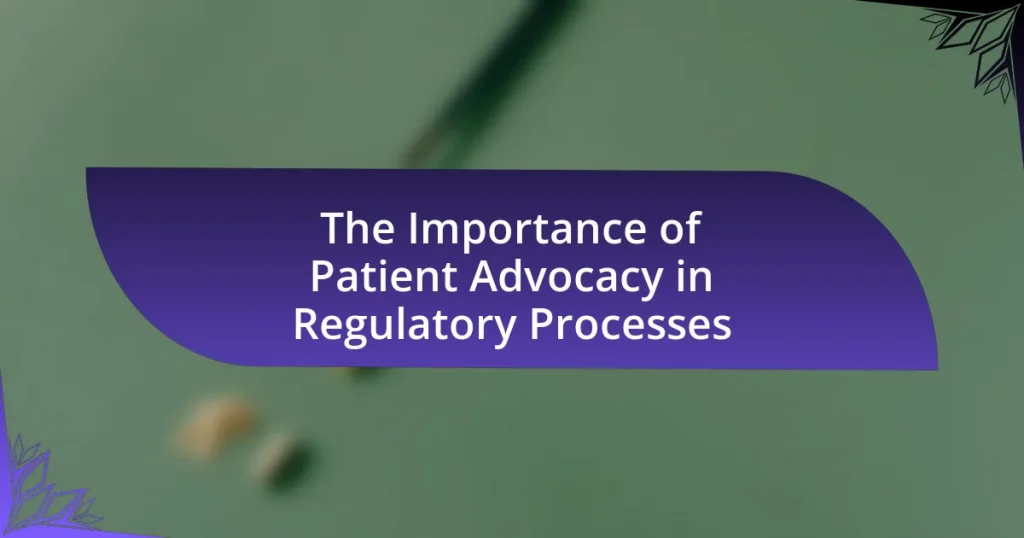Regulatory inspections in immunotherapy are critical evaluations conducted by authorities such as the FDA and EMA to ensure compliance with safety, efficacy, and quality standards in the development and manufacturing of immunotherapeutic products. This article outlines the importance of these inspections, the role of regulatory bodies, and the impact on product development. Key components of inspections, necessary documentation, and strategies for organizations to prepare effectively are discussed, including the significance of staff training and internal audits. Additionally, common challenges faced during inspections and best practices for maintaining compliance are highlighted, providing a comprehensive overview of how organizations can enhance their readiness for regulatory scrutiny in the immunotherapy sector.
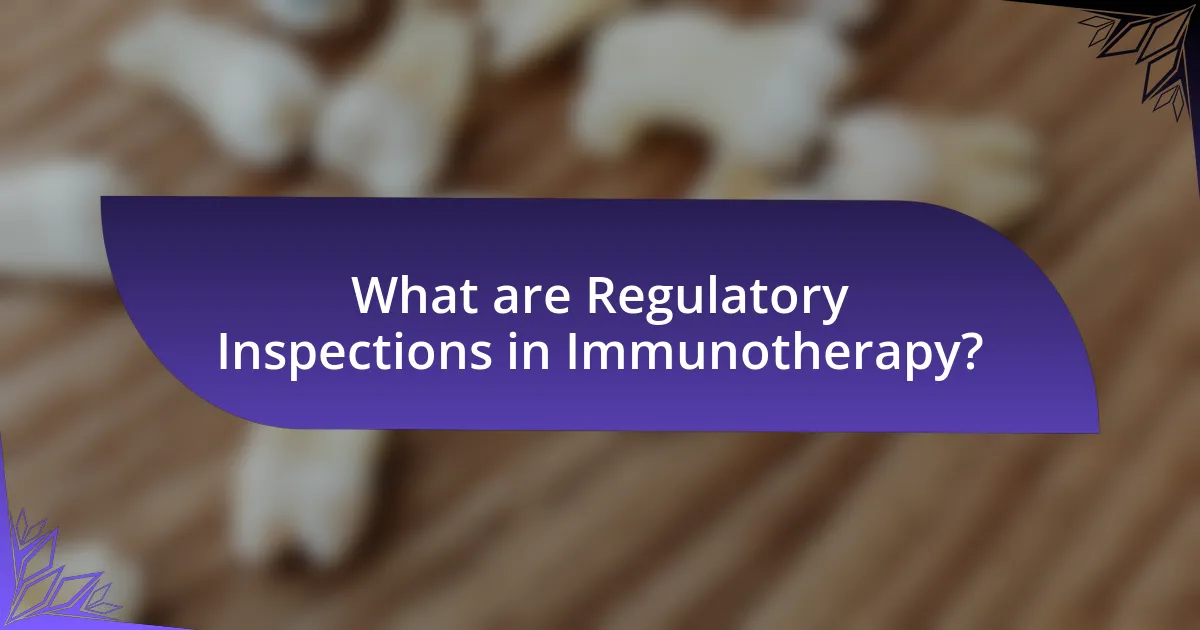
What are Regulatory Inspections in Immunotherapy?
Regulatory inspections in immunotherapy are evaluations conducted by regulatory authorities to ensure compliance with established guidelines and standards in the development and manufacturing of immunotherapeutic products. These inspections assess various aspects, including the quality control processes, clinical trial protocols, and adherence to Good Manufacturing Practices (GMP). Regulatory bodies, such as the U.S. Food and Drug Administration (FDA) and the European Medicines Agency (EMA), perform these inspections to safeguard public health and ensure that immunotherapies are safe and effective before they reach the market.
Why are Regulatory Inspections important in Immunotherapy?
Regulatory inspections are crucial in immunotherapy because they ensure compliance with safety, efficacy, and quality standards set by health authorities. These inspections help verify that immunotherapy products are developed and manufactured according to established guidelines, which is essential for protecting patient health and maintaining public trust. For instance, the U.S. Food and Drug Administration (FDA) conducts inspections to assess adherence to Good Manufacturing Practices (GMP), which are vital for minimizing risks associated with biological products. By identifying potential issues early, regulatory inspections facilitate timely corrective actions, thereby enhancing the overall integrity of immunotherapy treatments.
What role do regulatory bodies play in Immunotherapy inspections?
Regulatory bodies play a critical role in Immunotherapy inspections by ensuring compliance with safety, efficacy, and quality standards. These organizations, such as the FDA in the United States and EMA in Europe, establish guidelines that govern the development and approval of immunotherapeutic products. They conduct inspections to verify that manufacturers adhere to Good Manufacturing Practices (GMP) and other regulatory requirements, which helps to protect patient safety and maintain the integrity of clinical trials. For instance, the FDA’s Biologics Control Act mandates rigorous evaluation of biologics, including immunotherapies, to ensure they meet established safety and effectiveness criteria before they can be marketed.
How do regulatory inspections impact the development of Immunotherapy products?
Regulatory inspections significantly impact the development of immunotherapy products by ensuring compliance with safety, efficacy, and quality standards. These inspections assess manufacturing processes, clinical trial protocols, and data integrity, which are crucial for gaining regulatory approval. For instance, the U.S. Food and Drug Administration (FDA) conducts inspections to verify that companies adhere to Good Manufacturing Practices (GMP), which directly influences the timeline and success of product development. Non-compliance can lead to delays, increased costs, or even the rejection of product applications, as seen in cases where companies failed to meet regulatory requirements, resulting in halted trials or product recalls. Thus, regulatory inspections serve as a critical checkpoint that shapes the overall trajectory of immunotherapy development.
What are the key components of a Regulatory Inspection?
The key components of a Regulatory Inspection include the inspection scope, documentation review, facility assessment, personnel interviews, and compliance evaluation. The inspection scope defines the areas and processes to be examined, ensuring that all relevant aspects of the operation are covered. Documentation review involves examining records, protocols, and reports to verify adherence to regulatory standards. Facility assessment entails evaluating the physical environment and equipment to ensure they meet safety and operational requirements. Personnel interviews assess the knowledge and practices of staff involved in the processes under inspection. Compliance evaluation determines whether the organization meets applicable regulations and guidelines, often referencing specific regulatory frameworks such as Good Manufacturing Practices (GMP) or Good Clinical Practices (GCP).
What documentation is required for a successful inspection?
A successful inspection requires comprehensive documentation that includes the following: a detailed quality management system (QMS) manual, standard operating procedures (SOPs), training records, batch production records, and validation documentation. These documents ensure compliance with regulatory standards and demonstrate that processes are followed consistently. For instance, the QMS manual outlines the overall quality framework, while SOPs provide specific instructions for operations. Training records verify that personnel are adequately trained, and batch production records confirm that products are manufactured according to established protocols. Validation documentation supports the reliability of processes and equipment used in immunotherapy production.
How is facility compliance assessed during inspections?
Facility compliance is assessed during inspections through a systematic evaluation of adherence to regulatory standards and operational protocols. Inspectors review documentation, observe practices, and assess the physical environment to ensure compliance with guidelines set by regulatory bodies such as the FDA or EMA. This process often includes checking for proper record-keeping, equipment maintenance, staff training, and adherence to safety protocols. Compliance is validated through specific criteria outlined in regulations, such as the Good Manufacturing Practice (GMP) standards, which require facilities to maintain quality assurance and control measures.
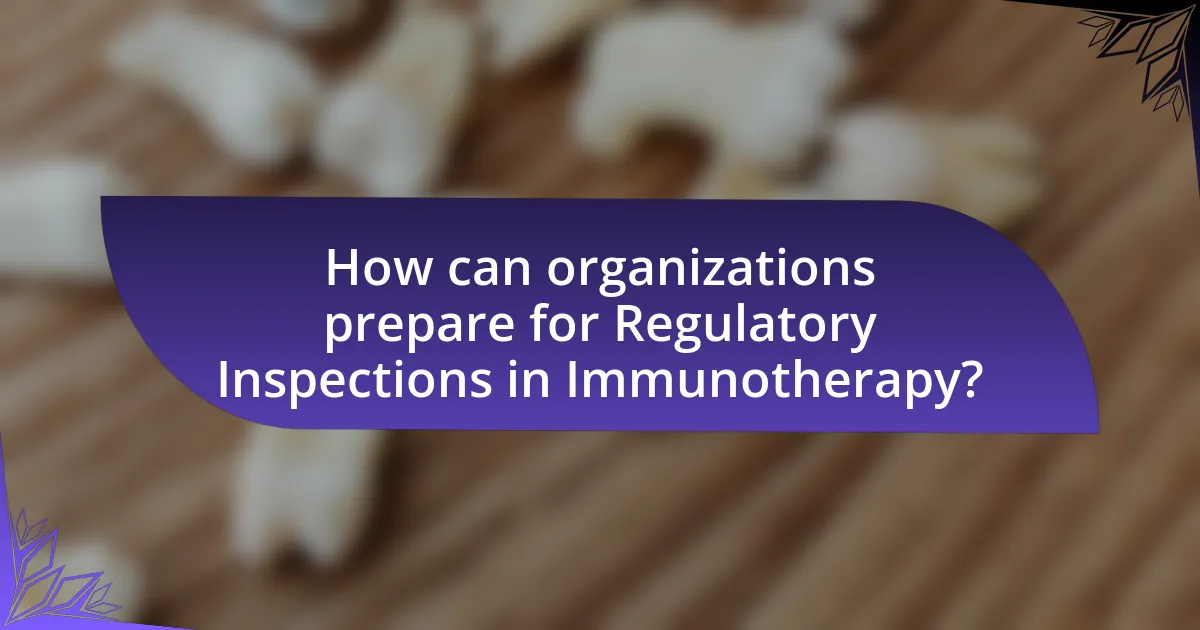
How can organizations prepare for Regulatory Inspections in Immunotherapy?
Organizations can prepare for regulatory inspections in immunotherapy by implementing comprehensive quality management systems and ensuring compliance with regulatory guidelines. This preparation involves conducting regular internal audits, maintaining thorough documentation of all processes, and training staff on regulatory requirements specific to immunotherapy. For instance, the FDA emphasizes the importance of Good Manufacturing Practices (GMP) in the production of immunotherapies, which necessitates that organizations adhere to stringent quality controls and validation processes. Additionally, organizations should engage in mock inspections to identify potential gaps and rectify them before actual regulatory reviews. This proactive approach not only enhances compliance but also fosters a culture of quality and accountability within the organization.
What steps should be taken to ensure compliance before an inspection?
To ensure compliance before an inspection, organizations must conduct a thorough internal audit of all relevant processes and documentation. This includes reviewing standard operating procedures (SOPs), ensuring that all records are up-to-date, and verifying that staff are trained on compliance requirements. Additionally, organizations should perform mock inspections to identify potential areas of non-compliance and address them proactively. According to the FDA, maintaining accurate and complete records is crucial for demonstrating compliance during regulatory inspections.
How can staff training improve inspection readiness?
Staff training can significantly improve inspection readiness by ensuring that employees are knowledgeable about regulatory requirements and best practices. Well-trained staff are more likely to adhere to protocols, maintain accurate documentation, and effectively communicate during inspections. Research indicates that organizations with comprehensive training programs experience fewer compliance issues and better inspection outcomes, as evidenced by a study published in the Journal of Regulatory Science, which found that facilities with regular training sessions had a 30% reduction in non-compliance findings during inspections. This highlights the direct correlation between staff training and enhanced inspection preparedness.
What internal audits should be conducted prior to an inspection?
Prior to an inspection, organizations should conduct internal audits focusing on compliance with regulatory standards, documentation accuracy, and operational procedures. These audits should include a review of quality management systems to ensure adherence to Good Manufacturing Practices (GMP), verification of training records for personnel involved in immunotherapy processes, and assessment of data integrity related to clinical trials and product development. Conducting these audits helps identify potential non-compliance issues and ensures that all processes align with regulatory expectations, thereby reducing the risk of findings during the actual inspection.
What common challenges do organizations face during Regulatory Inspections?
Organizations commonly face challenges such as inadequate documentation, lack of staff training, and insufficient understanding of regulatory requirements during regulatory inspections. Inadequate documentation can lead to non-compliance findings, as regulatory bodies require comprehensive records to verify adherence to guidelines. Lack of staff training often results in employees being unprepared to answer questions or provide necessary information, which can hinder the inspection process. Additionally, insufficient understanding of regulatory requirements can cause organizations to overlook critical compliance areas, leading to potential penalties or delays in product approval. These challenges highlight the importance of thorough preparation and ongoing education in regulatory compliance.
How can organizations address gaps in documentation?
Organizations can address gaps in documentation by implementing a systematic review process that identifies and rectifies deficiencies. This involves conducting regular audits of existing documentation to ensure compliance with regulatory standards, such as those set by the FDA or EMA, which require thorough and accurate records for immunotherapy practices. Additionally, organizations can establish a centralized documentation management system that facilitates easy access, updates, and tracking of all relevant documents. Research indicates that organizations with robust documentation practices are 30% more likely to pass regulatory inspections without major findings, highlighting the importance of addressing these gaps proactively.
What strategies can be employed to manage unexpected findings?
To manage unexpected findings during regulatory inspections in immunotherapy, organizations should implement a proactive response strategy. This includes establishing a clear communication plan to address findings promptly, conducting root cause analysis to understand the underlying issues, and developing corrective action plans to mitigate future occurrences. For instance, a study published in the Journal of Regulatory Science highlights that organizations that engage in thorough documentation and regular training are better equipped to handle unexpected findings effectively. Additionally, maintaining an open dialogue with regulatory bodies can facilitate a more collaborative approach to resolving issues, thereby enhancing compliance and trust.

What best practices can enhance preparation for Regulatory Inspections in Immunotherapy?
Best practices that can enhance preparation for regulatory inspections in immunotherapy include establishing a robust quality management system, conducting regular internal audits, and ensuring comprehensive documentation. A quality management system helps maintain compliance with regulatory standards, while internal audits identify potential gaps before inspections occur. Comprehensive documentation, including protocols, batch records, and training logs, provides clear evidence of adherence to regulations and facilitates a smoother inspection process. These practices are supported by the FDA’s guidance on quality systems, which emphasizes the importance of proactive compliance measures in the biopharmaceutical industry.
How can organizations create a culture of compliance?
Organizations can create a culture of compliance by establishing clear policies, providing comprehensive training, and fostering open communication. Clear policies outline expectations and legal requirements, ensuring that all employees understand their responsibilities. Comprehensive training programs equip staff with the knowledge necessary to adhere to regulations, which is essential in highly regulated fields like immunotherapy. Fostering open communication encourages employees to report concerns without fear of retaliation, promoting accountability and transparency. Research indicates that organizations with strong compliance cultures experience fewer regulatory violations and improved operational efficiency, highlighting the effectiveness of these strategies in maintaining compliance.
What role does continuous training play in maintaining inspection readiness?
Continuous training is essential for maintaining inspection readiness as it ensures that personnel are consistently updated on regulatory requirements and best practices. Regular training sessions reinforce knowledge of compliance standards, operational procedures, and quality control measures, which are critical during inspections. For instance, organizations that implement ongoing training programs report a 30% reduction in non-compliance issues during regulatory audits, demonstrating the effectiveness of continuous education in fostering a culture of compliance and preparedness.
How can organizations utilize mock inspections for better preparation?
Organizations can utilize mock inspections to enhance their preparation for regulatory inspections by simulating the actual inspection process, which allows them to identify gaps in compliance and improve their operational readiness. Conducting these mock inspections helps organizations familiarize their staff with inspection protocols, assess the effectiveness of their documentation, and ensure that all necessary resources are in place. For instance, a study published in the Journal of Regulatory Science highlighted that organizations that regularly conducted mock inspections reported a 30% increase in compliance readiness during actual inspections. This proactive approach not only mitigates risks but also fosters a culture of continuous improvement within the organization.
What are the key takeaways for successful Regulatory Inspection preparation?
Key takeaways for successful Regulatory Inspection preparation include thorough documentation, staff training, and mock inspections. Thorough documentation ensures that all processes and protocols are clearly recorded, which is essential for demonstrating compliance with regulatory standards. Staff training is crucial as it equips team members with the knowledge to respond effectively during inspections, thereby minimizing errors and misunderstandings. Conducting mock inspections allows organizations to identify potential gaps in compliance and address them proactively, enhancing readiness for the actual inspection. These practices are supported by industry standards, such as the FDA’s guidance on Good Manufacturing Practices, which emphasizes the importance of preparation and compliance in regulatory processes.
How can organizations implement a checklist for inspection readiness?
Organizations can implement a checklist for inspection readiness by developing a structured framework that includes key compliance areas, documentation requirements, and personnel responsibilities. This framework should encompass specific regulatory guidelines relevant to immunotherapy, ensuring that all necessary protocols, standard operating procedures, and training records are readily accessible and up-to-date.
To validate this approach, organizations can reference the FDA’s guidance documents, which outline essential elements for maintaining compliance during inspections. By regularly reviewing and updating the checklist based on these guidelines, organizations can ensure they are prepared for regulatory scrutiny and can demonstrate adherence to industry standards.
What resources are available for ongoing compliance support?
Ongoing compliance support resources include regulatory agencies, industry associations, and compliance software tools. Regulatory agencies such as the FDA provide guidelines and updates on compliance requirements, while industry associations like the Biotechnology Innovation Organization offer resources and training for best practices. Additionally, compliance software tools can help organizations track regulatory changes and maintain documentation, ensuring adherence to standards. These resources collectively enhance an organization’s ability to stay compliant with evolving regulations in the immunotherapy sector.
